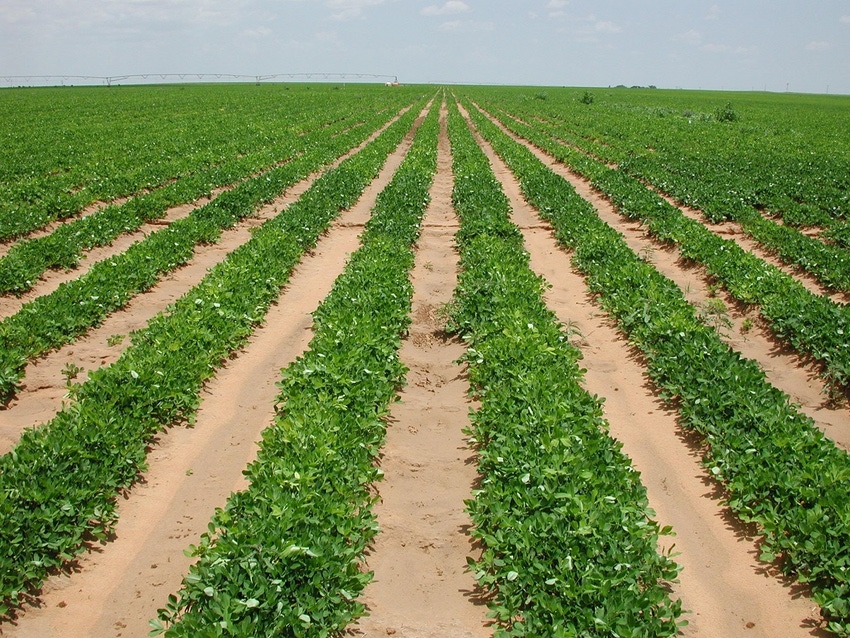
Conservative estimates indicate 2015 U.S. peanut acreage will be up about 15 percent over last year. That’s enough to keep pressure on prices, considering a 922,000-ton carry forward and not enough increase in domestic consumption and export—although both appear to be on an upward trend—to use up an average yield on that many more acres.
And if planted acreage goes higher, 20 percent or more, the glut will be significantly worse and farmer prices will continue to drop, putting more strain on the new farm program.
Tyron Spearman, Peanut Farm Market News, Tifton, Ga., says current estimates show acreage will be up at least 15 percent across the Peanut Belt. “Georgia will increase acreage by 22 percent,” he said, during opening remarks Thursday (March 26) at the 50th annual Oklahoma Peanut Expo.
A stipulation in the new farm program makes peanuts an attractive option, Spearman noted. Under the law, farmers with cotton base, now considered generic base, may set aside peanut base and still be paid as long as they don’t plant a covered crop on those acres. They can plant peanuts on the generic base and be eligible for payments on those planted peanuts as well. Peanuts also have a separate $125,000 payment limitation, per entity.
For the latest on southwest agriculture, please check out Southwest Farm Press Daily and receive the latest news right to your inbox.
Farmers across the Cotton/Peanut Belt are considering that opportunity as well as the current low price for cotton and the additional production cost many producers face this year in battling herbicide-resistant weeds as they finalize planting intentions.
Acreage a question mark
Acreage remains a question mark and may still depend on price fluctuations, contract availability and weather conditions at planting time. Spearman said seed availability also may be an issue if planted acreage pushes above that 20 percent estimate.
Todd Baughman, with the Oklahoma State University Institute for Ag Biosciences in Ardmore, contacted Extension peanut specialists prior to the Expo, which was held at the Quartz Mountain Resort near Lone Wolf, Okla., to get a feel for planting intentions.
Estimates across the peanut-producing states indicate planting intentions for 1.625 million acres, a 20 percent increase. That’s up from 1.35 million acres last year.
“This would be the first time in the last 20 years we’ve planted more than 1.6 million acres of peanuts,” Baughman said.
Breaking it down by state, Baughman, reports:
-Virginia will plant about 18,000 acres in 2015, a slight increase from 2014.
-North Carolina will plant about 110,000 acres, up 10,000 from 2014.
-South Carolina, at 106,000 acres, is about the same as last year. The state is shifting to more runner-type peanuts.
-Arkansas anticipates about 10,000 acres of peanuts, about the same as last year.
-Mississippi, at 40, 000 to 45,000 acres, will be up from 31,000 last year.
-Alabama will add 15 percent to 20 percent more acres to last year’s 175,000 to just over 200,000 acres.
-Florida also will tick up to 200,000 acres from 175,000 last year.
-Georgia peanut farmers will add significantly more peanuts in 2015, up from 585,000 last year to 700,000 to 750,000, with most of that increase in the eastern part of the state.
-New Mexico may move up 2,000 acres to 7,000 total this year.
-Texas planted 125,000 acres last year and “could see a substantial increase” in 2015, Baughman said.
-Oklahoma acreage may be slightly down from last year’s 12,000 acres. “But that’s still up in the air,” Baughman says.
Production challenges
The farm bill and seed supply could be issues for Oklahoma producers as they make final acreage plans. Irrigation capacity also will be a limiting factor. Much of Oklahoma’s peanut area remains in a four-year drought.
Another potential acreage indicator is the insured peanut acreage and the number of policies already reported. Deadline to buy insurance has passed, says Keith Schumann, vice president, AgriLogic Consulting, College Station, Texas. Reporting deadline is not until April 15. “We’ll know more after that,” he said.
So far, peanut farmers have purchased 22,150 policies on 1.2 million acres with a month to go to get in final reports. Last year, Schumann said, peanut producers bought 22,826 policies, covering 1.24 million acres.
“We’re comparable to those numbers now,” he said, “but we are not through the reporting period.”
Even with additional acreage, producers still have to make a crop to increase supply and a few areas face challenges, Baughman said. The farm bill is one of the biggest concerns for producers in every state as they make final planting decisions.
Oklahoma and parts of Texas still have weather issues and pockets of severe to exceptional drought. “Much of the Texas peanut area has the best soil moisture it’s had in recent years,” Baughman. “But that’s not saying a lot considering how dry the past few years have been.”
Weed pressures also concerns growers as they look for strategies to manage resistant- and hard-to-control weeds.
Water issues
Baughman says new producers will plant about half the acreage in Arkansas. Mississippi also will see new growers and new consultants working peanuts, and they face plant disease issues. “Harvest weather also causes concern. They have to get the crop out by October.”
Seed quality may be an issue for Alabama growers, and with increased acreage maintaining an adequate rotation could be problematic. Georgia, with a significant increase in acreage, will produce peanuts back-to-back or with only a one-year rotation. “Limited rotation could result in more disease pressure,” Baughman said.
“Texas producers are concerned with irrigation capacity. Also, they need cotton prices to strengthen. That’s the key to rotation.”
Florida peanut producers are concerned with nematodes.
With planting time approaching, producers will need to make final planting decisions soon and some observers fear that farmers will look at short-term opportunities and dismiss the long-term impact of planting too many peanuts, adding to surplus, disrupting rotation and perhaps jeopardizing the peanut safety net.
About the Author(s)
You May Also Like






